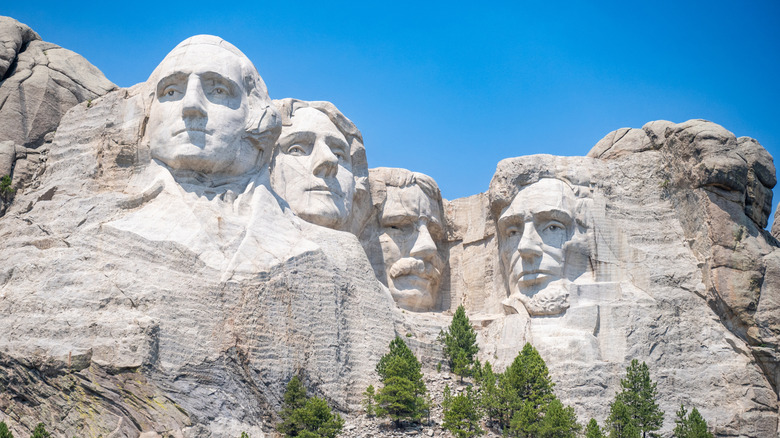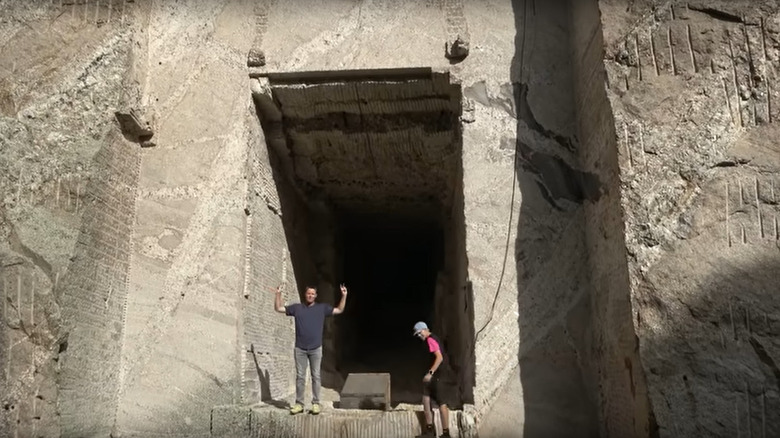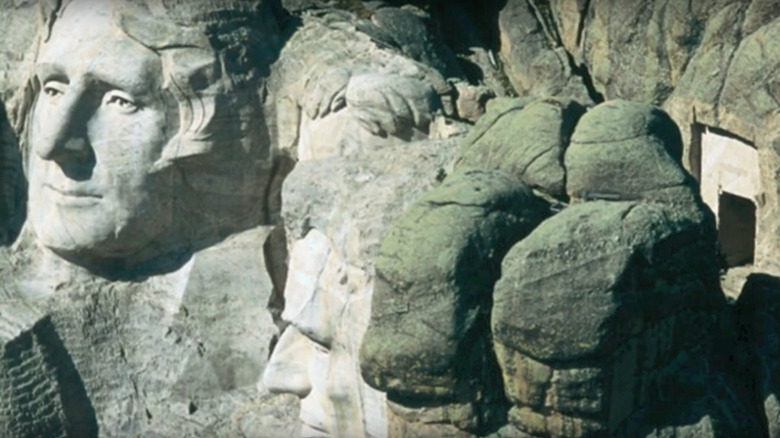Mount Rushmore's Secret Room Is An Inaccessible Shrine To America Hidden Within The Mountain
If you stop and think about it, it's pretty strange that the faces of four former U.S. presidents have been chiseled out of the granite mountainside in the Black Hills of South Dakota like impassive gods surveying the land below. But while staring up Thomas Jefferson's unnaturally angular nostrils is weird enough, it's even stranger to poke around the rear of Abraham Lincoln's stony skull. There, legends say, lies a hidden chamber shielded by 20-foot-tall glass doors and guarded by a massive bronze eagle. This chamber holds a 1,200-pound granite capstone that contains a titanium vault, which houses a wooden box holding 16 porcelain tablets, etched with words of the Declaration of Independence, the U.S. Constitution, the Bill of Rights, the Gettysburg Address, and information about the Danish-American sculptor who designed this bizarre Hall of Records, Gutzon Borglum. As improbable as all this sounds, it's not just a legend. It's 100% true — minus the eagle and doors.
We have Borglum to thank not only for this most unseen of rocky rooms, but also for granting us Mount Rushmore itself. When he died in 1941, the same year that World War II kicked off, he left his full vision for the monument incomplete. The initial entryway of the Hall of Records was blasted into the stone behind Lincoln's head, but the site was left untouched until 1998 when the tablets, titanium vault, and capstone were added. This doesn't mean that you can visit the Hall of Records, however — at least legally and with exception. Visitors to Mount Rushmore can hike the 425-step Presidential Trail that passes under the presidents' faces, but the adjoining pathway to the Hall of Records isn't open to the public.
Inside the unfinished Hall of Records at Mount Rushmore
It sounds absurd, like something out of a fictional vault infiltrated by Nicolas Cage in a "National Treasure" movie, but nope. The Hall of Records is the real deal. But before you start planning an urban exploration escapade to Mount Rushmore's least-kept secret, remember that it's off-limits. You can go inside the Statue of Liberty rather than just viewing it from a free Staten Island ferry. You can hike down into the Grand Canyon along its most heat-choked trail, no matter how dangerous. But you can't — repeat, can't — get inside the Hall of Records. Unless you operate a big YouTube channel like What's Inside and the U.S. Department of the Interior grants you exclusive access, that is. Barring that, visitors to Mount Rushmore might have to settle for zip lining at the nearby Rush Mountain Adventure Park to get their thrills.
This is especially true because the Hall of Records' strongest selling point is its inaccessibility. The room itself is a short, roughly hewn hallway blasted directly into Mount Rushmore's granite, and that's it. And we say "blasted" because the wall at the hall's dead end has holes drilled into it for sticks of dynamite, which is also how workers built the presidents' faces. The whole scene speaks to how quickly the project was abandoned and then left precisely as it was. It's a far cry from Gutzon Borglum's original plan to build an 800-foot-high stone stairway leading to a final, 80-foot-by-100-foot inner sanctum, but it's a remnant, at least.
What's the purpose of the Hall of Records?
When learning about the Hall of Records behind Abraham Lincoln's head at Mount Rushmore, the first question that many people will likely ask is, "Why?" As you might guess, the unfinished room was meant to serve as a kind of shrine to the ideals of the United States — liberty, freedom, and so forth. It was intended to focus on the country's history from 1776 to 1906 and highlight nine critical events that happened during that time.
More broadly, the room was envisioned as part time capsule, part defense against humanity's inevitable doom, and part message to visitors from the stars or post-apocalyptic survivors: We were here, we were America, and this is what we were all about. Or, as Gutzon Borglum wrote — and as the hall's granite capstone eloquently declares about the entire Mount Rushmore monument, "... let us place there, carved high, as close to heaven as we can, the words of our leaders, their faces, to show posterity what manner of men they were. Then breathe a prayer that these records will endure until the wind and rain alone shall wear them away."
Until then, visitors to Mount Rushmore can poke along the Presidential Trail, which includes features like the Lakota, Nakota, and Dakota Heritage Village and the Sculptor's Studio. That sculptor, of course, was Borglum. In the studio, you can view his miniature version of Mount Rushmore and have a look at his drafts of the Hall of Records that never materialized. With a good enough imagination, you might even envision visiting his masterpiece that now dwells forever out of reach.


